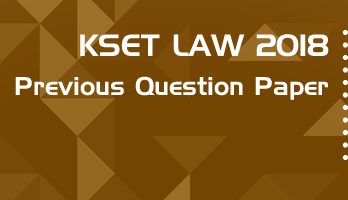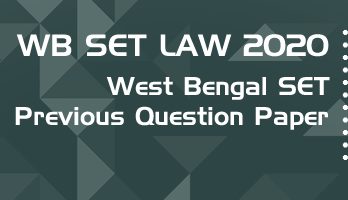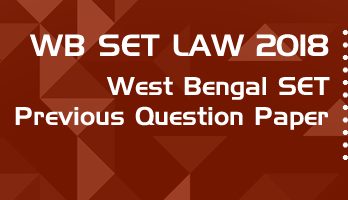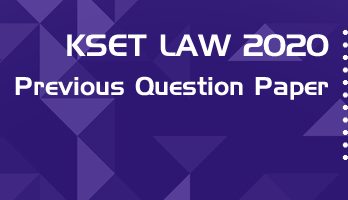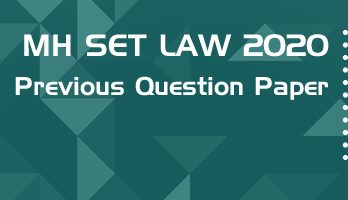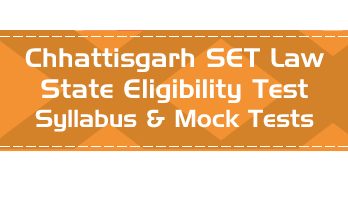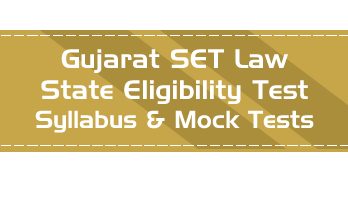26. Which one of the following is sufficient to prove the offence of sedition ?
(A) Comments expressing disapproval of the policies of the government with a view to obtain a change in policies by lawful means
(B) Proof of disloyalty or ill feelings
(C) Comments expressing disapproval of the administrative action even though do not excite hatred or disloyalty
(D) Exciting disaffection towards the government
27. A bullock-cart carrying a box of treasure is intercepted by A. The offence of theft is committed by A if and as soon as
(A) He seizes the bullock
(B) The bullock is made to move by him in his direction
(C) He takes the box of treasure
(D) He takes the valuable contents of the treasure
28. A obtained a sum of Rs. 10,000 from B by putting B in fear of death. Which one of the following offences was committed by A ?
(A) Cheating
(B) Robbery
(C) Mischief
(D) Extortion
29. A is found guilty of attempt to murder in furtherance of common intention. Under which one of the following situations can his offence be proved ?
(A) A procured the weapon of offence voluntarily
(B) The weapon of offence was taken away from A’s house without his knowledge
(C) A was made to purchase the weapon of offence under the threat to his own life
(D) When the weapon was snatched away from A he did not report the same to police
30. Environment Impact Assessment Notification 2006 has replaced the public hearing with which of the following ?
(A) Public consultation
(B) Screening
(C) Appraisal
(D) Public opinion
31. The Scheduled Tribes and Other Forest Dwellers Recognition of Rights Act, 2006 provides rights for the first time to the forest dwellers on the basis of
(A) Ownership
(B) Usage
(C) Assignment
(D) Record of rights
32. The given item consists of two statements one labelled as the ‘Assertion (A)’ and the other as ‘Reason (R)’. Examine these two statements carefully and select the answers to these items using the codes given below :
Assertion (A) : Water pollution is a form of nuisance and the Executive Magistrate is empowered to order a person to restrain from polluting a water body under Section 133 of Criminal Procedure Code.
Reason (R) : Water (Prevention and Control of Pollution) Act, 1974 is a special legislation dealing with water pollution hence general law provisions pertaining to water pollution are not applicable for regulating water pollution.
(A) Both A and R are individually true and R is the correct explanation of A
(B) Both A and R are individually true, but R is not the correct explanation of A
(C) A is true, but R is false
(D) A is false, but R is true
33. Match List I with List II and select the correct answer from the codes given below the
List I
I. Suspended particulate
II. Industrial Emissions
III. Sewage effluent
IV. Demolition Debris
List II
1. Municipal solid matter waste
2. Water (Prevention and Control of Pollution) Act, 1974
3. Environment (Protection) Rules, 1986
4. Air (Prevention and Control of Pollution) Act, 1981
Codes : I II III IV
(A) 4 3 2 1
(B) 1 2 3 4
(C) 3 2 1 4
(D) 4 1 2 3
34. Polluter Pays Principle is declared as law of the land in India in which of the following decisions of Supreme Court of India ?
(A) Indian Council for Enviro Legal Action V Union of India (AIR 1996 SC 1446)
(B) Subash Kumar V State of Bihar (AIR 1991 SC 420)
(C) MC Mehta V Union of India (1997 (II) SCC 312)
(D) Narmada Bachao Andolan V Union of India (AIR 1999 SC 3345)
35. Arrange the following in the order in which Supreme Court of India declared them as law of the land
I. Public Trust Doctrine
II. Precautionary Principle
III. Right to Environment as part of Right to Life
IV. Polluter Pays Principle
(A) I IV III II
(B) II III IV I
(C) IV III II I
(D) III IV II I
36. Which among the following powers are available to Pollution Control Board as per The Water (Prevention and Control of Pollution) Act, 1974.
I. Sample collection and sending them for laboratory verification
II. Close the erring industries
III. Initiate action against erring industries
IV. All the above
Select the correct answer
(A) I and II
(B) IV
(C) I II and III
(D) I and III
37. “International law is not true law, it is only positive international morality” – who defined it ?
(A) John Austin
(B) Hall
(C) Starke
(D) Gray
38. “International law or the law of nations is the name for a body of rules which according to the usual definition regulate the conduct of the States in their intercourse with one another” – who defined it ?
(A) John Austin
(B) Torsten Gihl
(C) Kelsen
(D) World Court
39. The father of modern law of nations is
(A) Starke
(B) John Austin
(C) Jeremy Bentham
(D) Hugo Grotius
40. Article 38 (1) (c) of the statute of ICJ provides about “the general principles of law recognised by civilised nations”. What does it mean ?
(A) Principles of natural justice are general principles recognised by civilised States
(B) Res judicata, estoppel, res subjudice, etc are the general principles of law recognized by civilised States
(C) General principles of law recognised by civilised States include both procedural and substantive laws
(D) All the above
41. ‘Specific Adoption Theory’ means
(A) International law can be applied in sovereign states directly without the adoption of that sovereign State, but by the direction and adoption of the UNO
(B) International law cannot be applied in sovereign States directly; unless and until that sovereign state specifically adopts that law by way of enactments
(C) As soon as the general assembly passes a rule, the sovereign state should specifically adopt that rule in its municipal laws
(D) None of the above
42. ‘Transformation Theory’ means
(A) International law spreads universally, but this law has to undergo transformation, if it is applied to municipal law
(B) The international law cannot be applied to municipal law
(C) Municipal law gradually transforms to international law
(D) None of the above
43. ‘Delegation Theory’ means
(A) The municipal laws delegate the rule making power to international law
(B) The international law delegates the rule making power to each State in accordance with the procedure and system prevailing in each State in accordance with the Constitution and rules of the treaty or any other convention at international level
(C) Municipal law gradually transfers and delegates into international law
(D) None of the above
44. A child of void marriage is
(A) entitled to an interest in which his father is a coparcener
(B) not entitled to an interest in which his father is a coparcener
(C) may or may not be entitled to an interest in which his father is a coparcener
(D) entitled of interest is discretionary to the court
45. Proceedings for restitution of conjugal rights enables the aggrieved spouse for
(A) maintenance under Section 25 of Hindu Marriage Act, 1955
(B) maintenance pendente lite under Section 24 of Hindu Marriage Act, 1955
(C) both (A) and (B)
(D) either (A) or (B)
46. During judicial separation
(A) parties continue to be husband and wife but marital rights and obligations are suspended
(B) parties continue to be husband and wife and marital rights and obligations remain intact
(C) parties continue to be husband and wife and may suspend or may not suspend the marital rights and obligations
(D) parties cease to be husband and wife
47. Doctrine of recrimination provides that
(A) if both parties, independent of each other, have committed matrimonial offences, the marriage should be dissolved
(B) if both parties, independent of each other, have committed matrimonial offences, the marriage should not be dissolved
(C) if both parties, independent of each other, have committed matrimonial offences
(D) either (A) or (C)
48. Conversion from Hindu to another religion is a ground for divorce
(A) under Section 13 (1) (ii) of the Hindu Marriage Act of 1955
(B) under Section 13 (1) (iii) of the Hindu Marriage Act of 1955
(C) under Section 13 (1) (iv) of the Hindu Marriage Act of 1955
(D) under Section 13 (1) (v) of the Hindu Marriage Act of 1955
49. Father-in-law’s obligation to maintain the daughter-in-law is
(A) a personal obligation
(B) co-extensive with ancestral property in the hands of father-in-law
(C) co-extensive with the personal property of the father-in-law
(D) both (B) and (C)
50. The ‘Absolute Theory’ as the basis for liability in tort for industrial injuries was propounded by
(A) Black Burn J.
(B) V.R. Krishna Iyer J
(C) P.N. Bhagwati
(D) Lord Atkin


